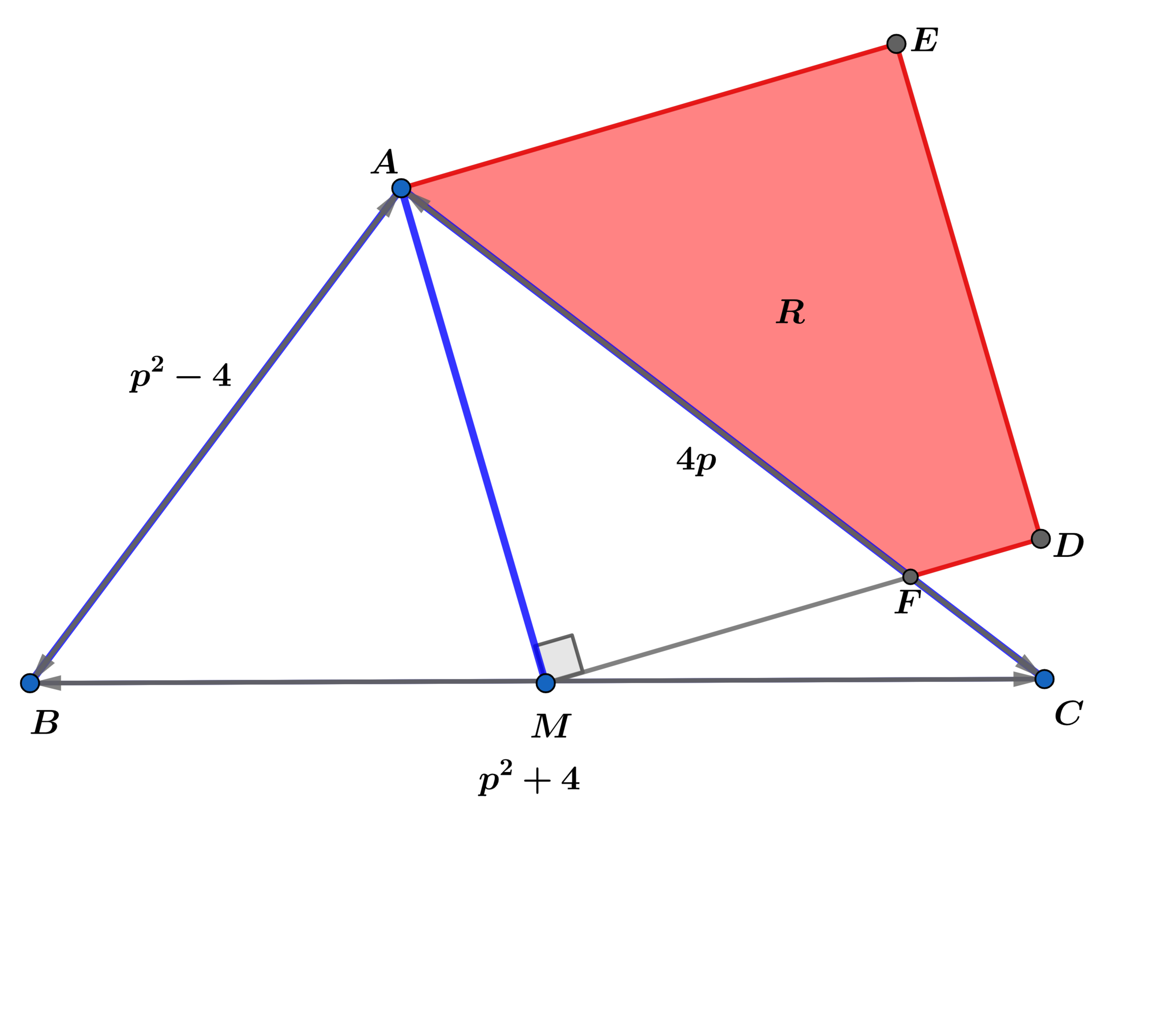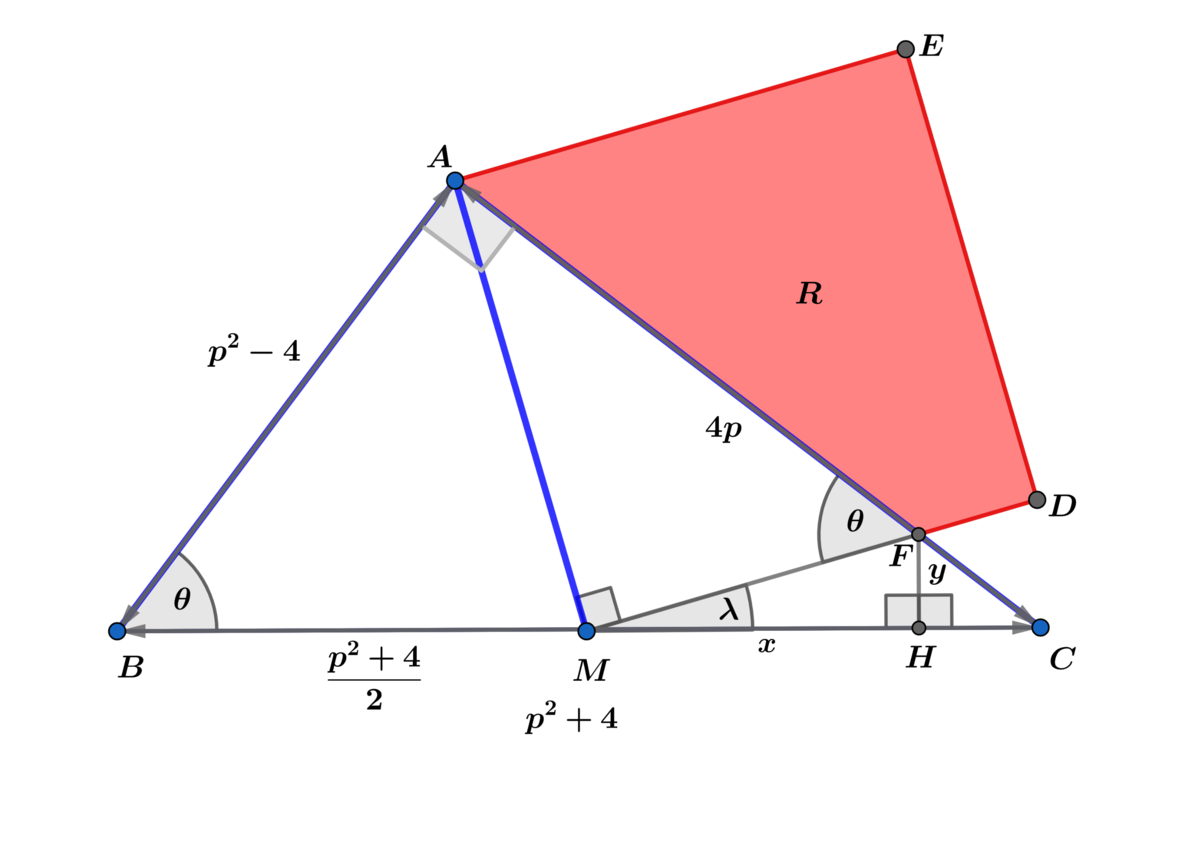P.P.T and Areas!

Let p be prime and p > 2 .
In △ A B C , A B = p 2 − 4 , A C = 4 p , B C = p 2 + 4 , M is a midpoint of B C and A M is a side of square M A E D and M D intersects A C at F .
If there exists a unique value of prime p > 2 for which M D intersects A C at F ( I . E ; for which the above construction is possible), then enter the value of A A E D F or else enter 0 .
The answer is 33.4479166666666667.
This section requires Javascript.
You are seeing this because something didn't load right. We suggest you, (a) try
refreshing the page, (b) enabling javascript if it is disabled on your browser and,
finally, (c)
loading the
non-javascript version of this page
. We're sorry about the hassle.
2 solutions

Let p > 2 .
( p 2 − 4 , 4 p , p 2 + 4 ) is a Pythagorean triple ⟹ △ A B C is a right triangle with m ∠ A = 9 0 ∘ and cos ( θ ) = p 2 + 4 p 2 − 4 .
Using the law of cosines on △ B A M with included ∠ A B C = θ ⟹
A M 2 = ( p 2 − 4 ) 2 + 4 p 2 + 4 − 2 ( p 2 − 4 ) ( 2 p 2 + 4 ) ( p 2 + 4 p 2 − 4 ) ⟹ A M = 4 p 2 + 4
⟹ M F = A F cos ( θ ) = p 2 + 4 p 2 − 4 A F ⟹ 4 ( p 2 + 4 ) 2 + ( p 2 + 4 ) 2 ( p 2 − 4 ) 2 A F 2 = A F 2
⟹ 4 ( p 2 + 4 ) 2 = ( p 2 + 4 ) 2 1 6 p 2 A F 2 ⟹ A F 2 = 6 4 p 2 ( p 2 + 4 ) 4 ⟹ A F = 8 p ( p 2 + 4 ) 2
⟹ M F = 8 p ( p 2 + 4 ) ( p 2 − 4 ) ⟹ A △ A M F = 3 2 p ( p 2 + 4 ) 2 ( p 2 − 4 ) ⟹
A A E D F = A R = A A E D M − A △ A M F = 3 2 p ( p 2 + 4 ) 2 ( 8 p − p 2 + 4 ) .
To show that there exists a unique prime value of p that satisfies the above construction.
λ = 2 θ − 9 0 ∘ ⟹ m M F = tan ( 2 θ − 9 0 ∘ ) = sin ( 2 θ ) − cos ( 2 θ ) = 2 sin ( θ ) cos ( 2 θ ) sin 2 ( θ ) − cos 2 ( θ ) =
8 p ( p 2 − 4 ) ( p − 2 ) 2 ( 4 + 4 p − p 2 ) > 0 and we already have p > 2 ⟹
p 2 − 4 p − 4 < 0 ⟹ p = ⌊ 2 ( 2 + 1 ) ⌋ = 4 ⟹ ( 2 < p ≤ 4 )
⟹ prime p = 3 ⟹ A R = 9 6 3 2 1 1 = 3 3 . 4 4 7 9 1 6 6 6 6 6 6 6 6 6 6 7 .
As long as A B < A C , the M D will intersect A C . Therefore, p 2 − 4 < 4 p , which solves to 2 − 2 2 < p < 2 + 2 2 or − 0 . 8 2 8 < p < 4 . 8 2 8 , which makes p = 3 the only possible prime number for p > 2 .
If p = 3 , then A B = p 2 − 4 = 3 2 − 4 = 5 , A C = 4 p = 4 ⋅ 3 = 1 2 , and B C = p 2 + 4 = 3 2 + 4 = 1 3 .
Since 5 2 + 1 2 2 = 1 3 2 , △ A B C is a right triangle, and by Thales's Theorem right ∠ A will lie on the circle that has B C as its diameter.
Since M is the midpoint of B C , M is the center of that circle, and M B = M A = M C = 2 1 3 , so △ A C M is an isosceles triangle.
As two base angles of an isosceles triangle, ∠ M C A = ∠ M A C , which means △ A M F ∼ △ C A B by AA similarity.
Since △ A M F ∼ △ C A B , M F = M A ⋅ A C A B = 2 1 3 ⋅ 1 2 5 = 2 4 6 5 .
Then A A E D F = A M A E D − A △ A M F = A M 2 − 2 1 ⋅ M F ⋅ A M = ( 2 1 3 ) 2 − 2 1 ⋅ 2 4 6 5 ⋅ 2 1 3 = 9 6 3 2 1 1 ≈ 3 3 . 4 4 7 9 .